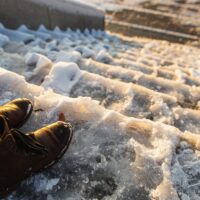Common Causes for Staircase Slip and Fall

Staircase slip and falls are extremely dangerous. Tripping on the ground level is already hazardous enough, but when you add height, repeated impact of multiple stairs, and the possibility of hitting other obstructions, stairs are that much more frightening when kept in an unsafe condition. Below, we discuss the most common causes for slip and fall accidents on staircases. If you or a loved one has been injured in a staircase accident in the Hudson Valley, call a seasoned New York premises liability attorney for assistance.
Broken or Missing Handrails
Staircases must come equipped with proper handrails to provide support and prevent falling either off the side of the staircase or down the steps. Staircases in older buildings might not be equipped with up-to-code handrails, they may be in poor condition and ready to collapse with a minor amount of weight, or there may be no handrails installed at all. If you fall on a staircase because of a faulty or missing handrail, you have a claim against the building operator.
Uneven/Poorly Built Stairs
As you walk up the stairs, you fall into a rhythm. You get a sense of where each step is located and how much to lift your foot to meet the next step. Uneven steps throw off that rhythm unexpectedly, making it much more likely that the person walking up or down is going to trip or miss a step entirely. Uneven and otherwise poorly constructed staircases, especially in older buildings, pose a significant hazard to people traversing.
Inadequate Lighting
Staircases can be dangerous at the best of times. If the stairwell lacks proper lighting, it becomes much more difficult to find the next step and/or the handrail. Walking up or down the stairs in the dark is significantly more dangerous and often leads to accidents and injuries.
Weak Flooring/Staircase Collapse
Building owners and operators have a responsibility to ensure that staircases are kept in good condition. If there has been flooding or termites, or simply a lot of time since the staircase was built, the steps themselves might be weak or damaged. Falling through a damaged step or a collapsed staircase is extremely dangerous and likely to lead to severe injury or worse.
Wet/Icy Stairs
Staircases are just like other floors: If ice, water, or other hazards are present, the owners and operators have a responsibility to remedy the situation. Slippery staircases are even more dangerous than slippery floors. If there’s been a spill or other guests/employees have tracked water or ice onto the stairs, and the owner/operator knows or should know about the slipping hazard, they can be held liable for resulting injuries.
Loose Carpeting
Carpeting is a useful solution to the dangers of wet and icy staircases. However, the carpeting must be snug and properly installed. Loose carpeting that bunches up or slides when stepped on can present a tripping or slipping hazard just as dangerous as wet stairs.
Discarded Objects and Other Obstructions
Any object left on the staircase, such as a box, tool, or loose electrical cord, presents a tripping hazard to anyone traversing the stairs. Small objects can be hard to detect, especially when walking down the stairs, but they are no less dangerous. If the owners or operators of the property knew or should have known about the loose debris or other hazardous object, they have a duty to either remedy the situation or warn about the danger.
If you or someone you care about has been hurt in a staircase accident in New York, find out if you have a right to compensation for your injuries by contacting the talented and thorough Hudson Valley personal injury lawyers at Rusk, Wadlin, Heppner & Martuscello, LLP for a free consultation at 845-331-4100 (Kingston) or 845-236-4411 (Marlboro).